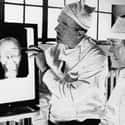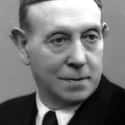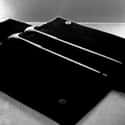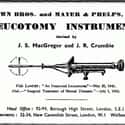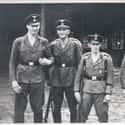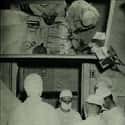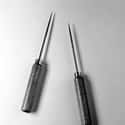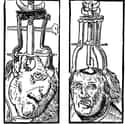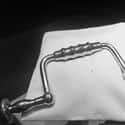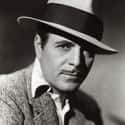-
(#1) Gottlieb Burkhardt Removed Parts Of Schizophrenic Patient's Brains In The 1890s
Gottlieb Burkhardt, a doctor at a mental asylum in Switzerland, was inspired by the work of Friederich Golz, who removed parts of the brains of dogs to make them calmer. In 1892, Burkhardt decided to conduct a similar procedure on six patients in his asylum. All suffered from agitation and hallucinations. Burkhardt removed sections of their cerebral cortex in the hopes of curing them.
Although the complete results of his procedure (which didn't yet have a name) are unknown, the four who survived the operation were reportedly calmer. However, Burkhardt's experiments were viewed negatively in the medical community, so for 40 years, research into this new field of surgery was heavily frowned upon.
-
(#2) Moniz, An Argentinean Neurologist, Was Awarded A Nobel Prize For Inventing The Procedure, Which Was Then Known As A "Leucotomy"
In the 1920s and '30s, a neurologist in Argentina named Antonio Egas Moniz fine-tuned a procedure that he called a leucotomy. It involved drilling holes in the front sections of the skull, then inserting a metal implement with a wire attached to demolish segments of the tissue in the frontal lobe of the brain. After this was completed, he poured a small amount of absolute alcohol into that part of the brain to kill any remaining live tissue.
His procedure was reportedly so successful (or so people believed at the time) that Moniz was awarded a Nobel Prize in Medicine in 1949.
-
(#3) Psychologist Walter Freeman Renamed And Simplified The Procedure, Turning It Into The Ice Pick Lobotomy
American psychologist Walter Freeman took Moniz's ideas to a different level. Freeman simplified the procedure and renamed it the lobotomy. Instead of drilling holes into a patient's brain, he simply inserted an implement that resembled an ice pick into their eye sockets. This made recovery time faster, since there were no incisions. Also, rather than using Moniz's two-pronged approach of a leucotomy tool and alcohol, Freeman simply severed the connections between the front lobe and the rest of the brain.
This became known as a transorbital lobotomy, the procedure that most people associate with the word, "lobotomy."
-
(#4) The Procedure Was Used To Treat Schizophrenia, Compulsive Disorders, And Depression
Prior to the beginning of the WWII, there were over 400,000 people in mental institutions. During the early 20th century, most people with a mental illness were put into institutions. The lobotomy was designed to help the patients, specifically those with schizophrenia, depression, and compulsive disorders.
Once they were treated, they would either be able to function in regular society, be cared for by family, or be less of a hassle for the nurses and orderlies in the asylums.
-
(#5) In The 1940s, Over 40,000 Americans Underwent The Procedure - Including A Four-Year-Old Child
Over the course of the 1940s, a whopping 40,000 people were lobotomized throughout the United States. In 1949 alone, 5,000 underwent the procedure. The people who received it weren't all adults either - one was a four-year-old child. Another was also a 12-year-old boy named Howard Dully who suffered from a "reluctance to go to bed on time" and had the bad habit of daydreaming.
Dully received his lobotomy in 1960, proof that it took some time for the procedure to fade out as a treatment option.
-
(#6) Joe Kennedy Had A Lobotomy Performed On His Daughter Rosemary, Because She Was A Potential Embarrassment To The Family
Rosemary Kennedy was the third child born to Joseph Sr. and Rose Kennedy. She was the younger sister of former President John F. Kennedy, and, due to a possible brain injury that she received at birth (a nurse reportedly held her in the birth canal for two hours while waiting for a doctor to arrive), Rosemary was the mentally slowest person in the entire family. This seemed fine when she was a child, but once she became an adult, her outbursts led her father to seek treatments.
Rosemary's sister, Kathleen, looked into the newest treatment at the time - the lobotomy. She rejected it as an option, but Joseph Sr. secretly took Rosemary to have it performed. It had drastic consequences, leaving her unable to walk properly or speak properly. As a result, she spent the rest of her life hidden away in a residential care facility and her plight inspired one of her sisters, Eunice, to create the Special Olympics.
-
(#7) Mentally Ill WWII Veterans Were Given Lobotomies To Treat What Is Now Known As PTSD
According to records found in the National Archives, nearly 2,000 World War II veterans received lobotomies. The lobotomies were performed on vets who had been diagnosed with depression, schizophrenia, and psychosis - all of which have symptoms overlapping with what is now known as PTSD. In some cases, war veterans received the lobotomies against their will, and for the most part, they were left with serious problems, such as seizures, the loss of motor skills, and even amnesia.
While it was a success for some of the men, the fact that the US Department of Veteran's Affairs didn't save any of the records in their current files and downplays the lobotomies, shows that weren't proud of having forced the procedure on the men whose wellbeing they were in charge of.
-
(#8) Psychologist Walter Freeman Once Performed 20 Lobotomies In One Day
Once Freeman had simplified his ice pick lobotomy procedure, he could perform many of them in one day. In his view, he was "helping" as many patients as possible. His record was 20 lobotomies in one day. Freeman was reportedly a bit of a showman and he enjoyed having an audience, even when the procedure went wrong and killed his patients.
Over the course of his career, Freeman performed 2,900 lobotomies, with his last one taking place in 1967 and ending with the death of the patient after Freeman accidentally severed a blood vessel in the person's brain.
-
(#9) Freeman Performed Lobotomies On A Disproportionate Amount Of Women And African Americans
In 2005, author Jack El-Hai was researching a book on Walter Freeman. Called The Lobotomist: A Maverick Medical Genius and His Tragic Quest to Rid the World of Mental Illness, it was contained plenty of information about Freeman and his practices. While researching, El-Hai uncovered some disturbing statistics about the patients who Freeman chose to undergo lobotomies: they were disproportionately female and African American.
Part of this was because doctors at the time believed that women were more likely to be able to function at home as caregivers after undergoing a lobotomy and they wouldn't need as much rehabilitation afterwards as someone who went out of the house to work. Another factor, according to Freeman's records, was that African Americans had greater family ties that would help them recover properly from the procedure.
-
(#10) The Lobotomy Turned Some Patients Into "Living Zombies"
In some cases, when it was done carefully, the lobotomy helped patients. However, most of the time, it had drastic consequences that resulted in patients becoming zombie-like versions of themselves. There are many stories of former lobotomy patients not being able to walk, talk, or even perform simple tasks after the procedure. Others were left feeling apathetic, forgetful, unreactive, or even careless.
While it did take away the violent tendencies of the mentally ill, it did so at a great cost.
-
(#11) The Idea For Lobotomy Stemmed From The Practice of Trepanning
Trepanning was an ancient practice that involved drilling holes in people's skulls for ritualistic purposes. Archeologists have found skeletons with trepanation holes that are thousands of years old. There is evidence that it was practiced in Ancient Greece, Polynesia, and even parts of Asia. The practice of trepanation didn't die out quickly - in fact, people in parts of Africa and Polynesia still used it up until the 19th century, where it became one of the inspirations for the lobotomy.
-
(#12) It Is Still Practiced In Some Countries To Curb Violent Behavior
Most of North America and Europe view the lobotomy as an archaic and barbaric procedure. However, some countries still practice it in the 21st century. These lobotomies are reserved for the most violent patients in India, Japan, Sweden, and Australia.
-
(#13) Actor Warner Baxter Received A Lobotomy To Help With His Arthritis Pain
Warner Baxter was a silent film star who was in movies like 42nd Street and The Cisco Kid. His career slowed down when films were no longer silent, but not because he didn't have the voice for it. Instead, he suffered from chronic pain and arthritis, which hampered his ability to function well while on set. The pain was so bad that he stopped eating properly.
The doctors decided to give him a lobotomy during his second hospitalization in the hope of lessening his pain. Whether or not the procedure worked is still uncertain, as Baxter developed pneumonia shortly afterwards and died in 1951 at the age of 62.
-
(#14) By The 1950s, Many Psychiatrists Preferred To Give Their Patients Medications Instead
By the early 1950s, the lobotomy was falling in popularity. John Fulton, an American doctor who initially trumpeted the praises of the lobotomy, changed his views of mental illness and began to favor medication-based therapies instead. By 1955, chlorpromazine, an early antipsychotic, was available in the United States. It was followed by haloperidol, another then-ground-breaking medication. These prescription drugs were viewed as less invasive and better for patients than a lobotomy.
New Random Displays Display All By Ranking
About This Tool
Lobotomy is neurosurgery that removes the connecting tissue of the prefrontal cortex of the brain. It was mainly used to treat some mental illnesses from 1930 to 1950. It was also the world's first psychiatric surgery. The recognized inventor of lobectomy won the Nobel Prize in Physiology and Medicine. However, less than a year later, Antonio Moniz was criticized, and the lobectomy began to be resisted worldwide.
Due to the low precision of the operation performed on the brain under crude conditions, and surgical patients had symptoms similar to dementia and mental retardation after the operation. The random tool explains 14 things about the crude surgical procedure of early lobotomy.
Our data comes from Ranker, If you want to participate in the ranking of items displayed on this page, please click here.











